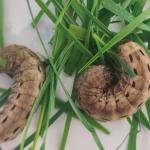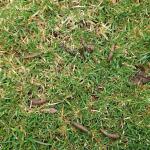Annual bluegrass weevil
All indications are that the 2023 season will be yet another challenging season for ABW management on golf courses. After a relatively warm winter, temperatures remain cool, resulting in very modest growing degree day (GDD) accumulations at most of our research sites. The winter temperatures were above normal in MA, and temperatures in March have been close to "normal".
GDD accumulation started in the second half of March and has been slow. The air temperature is expected to increase in the second week of April and most likely we will observe more rapid GDD accumulations in turn. However, for now the GDD accumulations are relatively similar across the sites we monitor and remain low (5 – 11 GDDs since March 1 – March 29), and Forsythia is not in bloom yet at our monitoring sites.
Despite low GDD accumulations and lagging Forsythia bloom, we have been observing ABW adults on the short-mowed grass since March 22 (on average 1-2 per 40 sec vacuum sample). According to sampling at different sites, only males were collected from fairways, and on the roughs, more females were collected than males (60% females and 40% males) at the time of monitoring. During the last week of March, the number of collected adults on fairways increased (on average 6-10 per 40 sec vacuum sample).
This week, 40% of all collected adults on fairways were females, which suggest that weevils moved out of the overwintering sites and the migration is at full speed. Further, weevil dissections revealed that that almost 100% of females collected on the fairways or greens have developed eggs. According to these observations we can assume a slightly early adult development, probably because of the warmer than usual winter. Similar observations on weevil activity and development were recorded by mid-April in 2021-2022.
We will continue monitoring adult activity but are expecting the peak within 1 -2 weeks if temperature increases. Thus, we are getting very close to the point of adulticide application in many locations, but we are still waiting for when the following factors come together: adult activity increases, GDD accumulation is near 100, and Forsythia or Bradford pear is at half-in-bloom-half-green.
Monitoring of ABW adult activity is critical at this time to pinpoint the best time for adulticides, which have short residual activity. Soap flushes, vacuuming, visual inspections of greens, and checking clippings collected from greens.
Winter cutworms
 This year we have received multiple reports regarding winter cutworm larvae found on the snow or feeding. We have been monitoring the activity of winter cutworms at the UMass Joseph Troll Turf Research center noted increased activity in March.
This year we have received multiple reports regarding winter cutworm larvae found on the snow or feeding. We have been monitoring the activity of winter cutworms at the UMass Joseph Troll Turf Research center noted increased activity in March.
The winter cutworm (Noctua pronuba) has been introduced from Europe and is very cold tolerant relatively to other turf insect pests. The life cycle of this species in New England has not been studied, but according to past observationd (by Dr. Pat Vittum), adults ("yellow underwing moths") are expected to fly in mid- to late summer, and they will lay eggs in late August to late September. The caterpillars are active and feed through the winter if temperatures are above 40º F. Currently the caterpillars (Fig.1) are finishing up their feeding and development and getting ready to pupate. Even though we haven’t seen any significant damage to the turfgrass in New England, this species can be devastating to plants in the family Poaceae (Gra mineae.. the grasses).
Please let me know (and send pictures) if you see any of these winter cutworms and associated damage. We are investigating their life cycle in New England and potential treatments.
Craneflies
 Around this time the damage caused by common craneflies (Tipula oleracea) becomes apparent and at high densities, severe. In addition, predators will dig to feed on relatively large larvae. However, insecticide application is not very effective, now because of the size of the larvae. If damage must be stopped, fast acting contact insecticides can be used on high-value turf areas, followed by irrigation (1/4”). Often larvae come to the surface after treatments (Fig. 2). We expect early development and adult flight this year (mid-April), so some of the larvae might be pupating at this time.
Around this time the damage caused by common craneflies (Tipula oleracea) becomes apparent and at high densities, severe. In addition, predators will dig to feed on relatively large larvae. However, insecticide application is not very effective, now because of the size of the larvae. If damage must be stopped, fast acting contact insecticides can be used on high-value turf areas, followed by irrigation (1/4”). Often larvae come to the surface after treatments (Fig. 2). We expect early development and adult flight this year (mid-April), so some of the larvae might be pupating at this time.
Submitted by: Dr. Olga Kostromytska